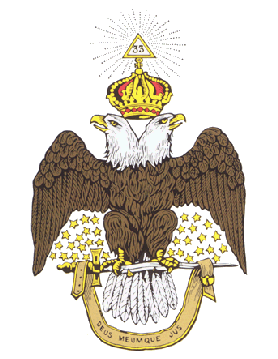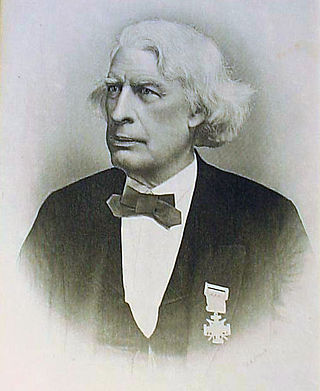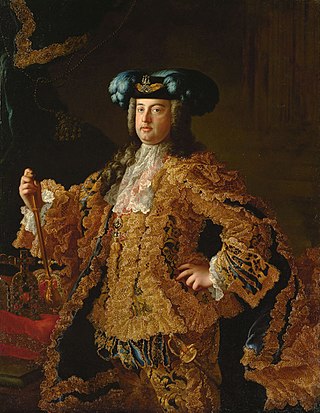
Freemasonry or Masonry refers to fraternal organisations that trace their origins to the local guilds of stonemasons that, from the end of the 13th century, regulated the qualifications of stonemasons and their interaction with authorities and clients. Modern Freemasonry broadly consists of two main recognition groups:

The Ancient and Accepted Scottish Rite of Freemasonry, commonly known as simply the Scottish Rite, is one of several Rites of Freemasonry. A Rite is a progressive series of degrees conferred by various Masonic organizations or bodies, each of which operates under the control of its own central authority. In the Scottish Rite the central authority is called a Supreme Council.

A Masonic lodge, often termed a private lodge or constituent lodge, is the basic organisational unit of Freemasonry. It is also commonly used as a term for a building in which such a unit meets. Every new lodge must be warranted or chartered by a Grand Lodge, but is subject to its direction only in enforcing the published constitution of the jurisdiction. By exception the three surviving lodges that formed the world's first known grand lodge in London have the unique privilege to operate as time immemorial, i.e., without such warrant; only one other lodge operates without a warrant – the Grand Stewards' Lodge in London, although it is not also entitled to the "time immemorial" title. A Freemason is generally entitled to visit any lodge in any jurisdiction in amity with his own. In some jurisdictions this privilege is restricted to Master Masons. He is first usually required to check, and certify, the regularity of the relationship of the Lodge – and be able to satisfy that Lodge of his regularity of membership. Freemasons gather together as a Lodge to work the three basic Degrees of Entered Apprentice, Fellowcraft, and Master Mason.

Albert Gallatin Mackey was an American medical doctor and author. He is best known for his books and articles about freemasonry, particularly the Masonic Landmarks.
A Grand Lodge is the overarching governing body of a fraternal or other similarly organized group in a given area, usually a city, state, or country.
Anti-Masonry is "avowed opposition to Freemasonry", which has led to multiple forms of religious discrimination, violent persecution, and suppression in some countries as well as in various organized religions. However, there is no homogeneous anti-Masonic movement. Anti-Masonry consists of radically differing criticisms from frequently incompatible political institutions and organized religions that oppose each other, and are hostile to Freemasonry in some form.
Co-Freemasonry is a form of Freemasonry which admits both men and women. It began in France in the 1890s with the forming of Le Droit Humain, and is now an international movement represented by several Co-Freemasonic administrations throughout the world. Most male-only Masonic Lodges do not recognise Co-Freemasonry, holding it to be irregular.
While many Christian denominations take no stance on, openly acknowledge, or allow Freemasonry, others discourage or prohibit their members from joining the fraternity.

Lodge Mother Kilwinning is a Masonic Lodge in Kilwinning, Scotland, under the auspices of the Grand Lodge of Scotland. It is number 0 on the Roll, and is reputed to be the oldest Lodge not only in Scotland, but the world. It is thus styled The Mother Lodge of Scotland attributing its origins to the 12th Century, and is often called Mother Kilwinning.
Masonic landmarks are a set of principles that many Freemasons claim to be ancient and unchangeable precepts of Masonry. Issues of the "regularity" of a Freemasonic Lodge, Grand Lodge or Grand Orient are judged in the context of the landmarks. Because each Grand Lodge is self-governing, with no single body exercising authority over the whole of Freemasonry, the interpretations of these principles can and do vary, leading to controversies of recognition. Different Masonic jurisdictions have different landmarks.
The Knight Kadosh is a Freemasonic degree or ceremony of initiation performed by certain branches of the Ancient and Accepted Scottish Rite of Freemasonry. It is the Thirtieth Degree of the Southern Jurisdiction of the Scottish Rite for the United States of America, and the Ancient and Accepted Scottish Rite of Freemasonry of Canada. The Northern Masonic Jurisdiction of the Scottish Rite, does not confer a degree entitled "Knight Kadosh." Instead its thirtieth degree is entitled "Grand Inspector."
Quatuor Coronati Lodge No. 2076 is a Masonic Lodge in London dedicated to Masonic research. Founded in 1886, the Lodge meets at Freemasons' Hall, Great Queen Street.
The Grand Orient of the Netherlands or Grand East of the Netherlands is a Masonic Grand Lodge in the Netherlands. It falls within the mainstream Anglo-American tradition of Freemasonry, being recognized by The United Grand Lodge of England and the 51 Grand Lodges in the United States. In addition to its jurisdiction over nine districts in the Netherlands, it also administers three Lodges in Suriname through the Provincial Grand Lodge of Suriname, three lodges in Curaçao, one in South Africa, one in Thailand, and through the Provincial Grand Lodge of the Caribbean, three lodges in Aruba and one in St. Maarten. In the Netherlands it claims to have 145 lodges with 5,792 members.

This is a chronology of the formation of "regular" or "mainstream" Masonic Grand Lodges in North America, descending from the Premier Grand Lodge of England or its rival, the Antient Grand Lodge of England. A Grand Lodge is the governing body that supervises "Craft" Freemasonry in a particular jurisdiction or geographical area.
Continental Freemasonry, otherwise known as Liberal Freemasonry, Latin Freemasonry, and Adogmatic Freemasonry, includes the Masonic lodges, primarily on the European continent, that recognize the Grand Orient de France (GOdF) or belong to CLIPSAS, SIMPA, TRACIA, CIMAS, COMAM, CATENA, GLUA, or any of various other international organizations of Liberal, i.e. Continental Freemasonry. The larger number of Freemasons, most of whom live in the United States–where Regular Freemasonry holds a virtual monopoly–belong to Masonic lodges that recognize the United Grand Lodge of England and do not recognize Continental Freemasons, regarding them as "irregular".
A Masonic Temple or Masonic Hall is, within Freemasonry, the room or edifice where a Masonic Lodge meets. Masonic Temple may also refer to an abstract spiritual goal and the conceptual ritualistic space of a meeting.
The National Mexican Rite is a rite of Freemasonry founded in Mexico in about 1834.
Abbé Larudan was an anonymous 18th Century French writer—possibly a clergyman for the Catholic Church, though this is unconfirmed—who is largely known for his Anti-Masonic writing, The Freemasons Crushed.

In Freemasonry, a Mason at sight, or Mason on sight, is a non-Mason who has been initiated into Freemasonry and raised to the degree of Master Mason through a special application of the power of a Grand Master.

The Grand Lodge of Ancient, Free And Accepted Masons of New Mexico is the oldest and largest of the two regular Masonic Grand Lodges in the State of New Mexico. It was founded on August 7, 1877, in Santa Fe, New Mexico.







